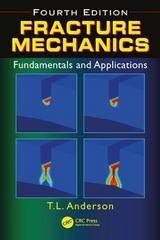
Fracture Mechanics
Crc Press Inc (Verlag)
978-0-8493-1656-2 (ISBN)
- Titel erscheint in neuer Auflage
- Artikel merken
With its combination of practicality, readability, and rigor that is characteristic of any truly authoritative reference and text, Fracture Mechanics: Fundamentals and Applications quickly established itself as the most comprehensive guide to fracture mechanics available. It has been adopted by more than 100 universities and embraced by thousands of professional engineers worldwide. Now in its third edition, the book continues to raise the bar in both scope and coverage. It encompasses theory and applications, linear and nonlinear fracture mechanics, solid mechanics, and materials science with a unified, balanced, and in-depth approach.
Reflecting the many advances made in the decade since the previous edition came about, this indispensable Third Edition now includes:
A new chapter on environmental cracking
Expanded coverage of weight functions
New material on toughness test methods
New problems at the end of the book
New material on the failure assessment diagram (FAD) method
Expanded and updated coverage of crack closure and variable-amplitude fatigue
Updated solutions manual
In addition to these enhancements, Fracture Mechanics: Fundamentals and Applications, Third Edition also includes detailed mathematical derivations in appendices at the end of applicable chapters; recent developments in laboratory testing, application to structures, and computational methods; coverage of micromechanisms of fracture; and more than 400 illustrations. This reference continues to be a necessity on the desk of anyone involved with fracture mechanics.
INTRODUCTION
History and Overview
Why Structures Fail
Historical Perspective
The Fracture Mechanics Approach to Design
Effect of Material Properties on Fracture
A Brief Overview of Dimensional Analysis
References
FUNDAMENTAL CONCEPTS
Linear Elastic Fracture Mechanics
An Atomic View of Fracture
Stress Concentration Effect of Flaws
The Griffith Energy Balance
The Energy Release Rate
Instability and the R Curve
Stress Analysis of Cracks
Relationship Between K and G
Crack-Tip Plasticity
K-Controlled Fracture
Plane Strain Fracture: Fact Versus Fiction
Mixed-Mode Fracture
Interaction of Multiple Cracks
Appendix 2: Mathematical Foundations of Linear Elastic Fracture Mechanics
References
Elastic-Plastic Fracture Mechanics
Crack-Tip-Opening Displacement
The J Contour Integral
Relationships Between J and CTOD
Crack-Growth Resistance Curves
J-Controlled Fracture
Crack-Tip Constraint Under Large-Scale Yielding
Appendix 3: Mathematical Foundations of Elastic-Plastic Fracture Mechanics
References
Dynamic and Time-Dependent Fracture
Dynamic Fracture and Crack Arrest
Creep Crack Growth
Viscoelastic Fracture Mechanics
Appendix 4: Dynamic Fracture Analysis
References
MATERIAL BEHAVIOR
Fracture Mechanisms in Metals
Ductile Fracture
Cleavage
The Ductile-Brittle Transition
Intergranular Fracture
Appendix 5: Statistical Modeling of Cleavage Fracture
References
Fracture Mechanisms in Nonmetals
Engineering Plastics
Ceramics and Ceramic Composites
Concrete and Rock
References
APPLICATIONS
Fracture Toughness Testing of Metals
General Considerations
Klc Testing
K-R Curve Testing
J Testing of Metals
CTOD Testing
Dynamic and Crack-Arrest Toughness
Fracture Testing of Weldments
Testing and Analysis of Steels in the Ductile-Brittle Transition Region
Qualitative Toughness Tests
Appendix 7: Stress Intensity, Compliance, and Limit Load Solutions for Laboratory Specimens
References
Fracture Testing of Nonmetals
Fracture Toughness Measurements in Engineering Plastics
Interlaminar Toughness of Composites
Ceramics
References
Application to Structures
Linear Elastic Fracture Mechanics
The CTOD Design Curve
Elastic-Plastic J-Integral Analysis
Failure Assessment Diagrams
Probabilistic Fracture Mechanics
Appendix 9: Stress Intensity and Fully Plastic J Solutions for Selected Configurations
References
Fatigue Crack Propagation
Similitude in Fatigue
Empirical Fatigue Crack Growth Equations
Crack Closure
The Fatigue Threshold
Variable Amplitude Loading and Retardation
Growth of Short Cracks
Micromechanisms of Fatigue
Fatigue Crack Growth Experiments
Damage Tolerance Methodology
Appendix 10: Application of the J Contour Integral to Cyclic Loading
References
Environmentally Assisted Cracking in Metals
Corrosion Principles
Environmental Cracking Overview
Stress Corrosion Cracking
Hydrogen Embrittlement
Corrosion Fatigue
Experimental Methods
References
Computational Fracture Mechanics
Overview of Numerical Methods
Traditional Methods in Computational Fracture Mechanics
The Energy Domain Integral
Mesh Design
Linear Elastic Convergence Study
Analysis of Growing Cracks
Appendix 12: Properties of Singularity Elements
References
Practice Problems
Index
| Erscheint lt. Verlag | 24.6.2005 |
|---|---|
| Zusatzinfo | 362 Illustrations, black and white |
| Verlagsort | Bosa Roca |
| Sprache | englisch |
| Maße | 178 x 254 mm |
| Gewicht | 1293 g |
| Themenwelt | Technik ► Maschinenbau |
| ISBN-10 | 0-8493-1656-1 / 0849316561 |
| ISBN-13 | 978-0-8493-1656-2 / 9780849316562 |
| Zustand | Neuware |
| Haben Sie eine Frage zum Produkt? |
aus dem Bereich



